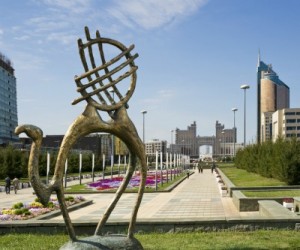REPORT: BIG CHANGES COMING TO KAZAKH MINING
Alexander Melikishvili, deputy head of Eurasia forecasting at London-based risk researcher Exclusive Analysis, recently acquired by IHS, says changes are underway in Kazakhstan’s resources industry.
The former Soviet republic is the globe’s top uranium producer and also exports vast quantities of copper – minerals make up nearly 90% of all exports. The country also holds one-third of the world’s chromium and manganese reserves.
Melikishvili says the restructuring of the Kazakstan’s mining and minerals industry was signaled on 16 January this year when president Nursultan Nazarbaev issued a decree establishing the Ministry of Regional Development and restructured other government bodies.
“This was likely undertaken in an effort to improve political stability and avoid economically motivated riots such as those that took place in Zhanaozen in December 2011,” says Melikishvili, adding that the “government reshuffle is likely to benefit manufacturing enterprises rather than extractive industries>”
The reasons are two-fold:
“First, the new structure reflects a shift away from visible, but ineffective industrialisation projects towards more nuanced economic planning, which also signifies a weakening position of Deputy Prime Minister Kairat Kelimbetov. This reflects the consolidation of power by a coordinating effort between the Minister of Environmental Protection Nurlan Kapparov and newly appointed head of the Ministry of Economy and Budgetary Planning, Yerbolat Dossayev. Unlike Kelimbetov, who has only managed government institutions, both Dossayev and Kapparov are prominent businessmen.”
Exclusive Analysis predicts that “all investment projects under the government’s consideration are likely to undergo more scrutiny to verify their contribution in terms of local job creation as well as sustainability and competitive export capacity.
“The strengthening of the Ministry of Environmental Protection, which has taken over the monitoring of the use of natural resources, water and fisheries from the Ministry of Agriculture, suggests that mining companies are likely to face more stringent enforcement of environmental regulations and control over working conditions.
“Additional presidential directives also indicate continued ascendance of the Minister of Industry and New Technologies Aset Isekeshev, who will be monitoring the progress made by the Kapparov/Dossayev unofficial partnership specifically with regard to local content.
“Second, changes in government structure reflect the shift of resources toward the regions, often sources of labour unrest. The newly created Ministry of Regional Development headed by Bakhytzhan Sagyntaev, former Minister of Economic Development and Trade, will be responsible for the coordination of new policies to be implemented at the regional level.
“It is very likely that with this purpose the Ministry of Regional Development will cajole both domestic and foreign mining companies into supporting educational, health and infrastructure upgrade projects.
“Manufacturing industries in the regions that can competitively produce labour-intensive goods for export, especially in road and industrial construction, industrial equipment and food processing to neighbouring countries, such as Russia and China, are likely to gain the most.
“Investors interested in developing renewable energy resources are likely to benefit as well,” says Melikishvili.
Frik Els | January 31, 2013
The former Soviet republic is the globe’s top uranium producer and also exports vast quantities of copper – minerals make up nearly 90% of all exports. The country also holds one-third of the world’s chromium and manganese reserves.
Melikishvili says the restructuring of the Kazakstan’s mining and minerals industry was signaled on 16 January this year when president Nursultan Nazarbaev issued a decree establishing the Ministry of Regional Development and restructured other government bodies.
“This was likely undertaken in an effort to improve political stability and avoid economically motivated riots such as those that took place in Zhanaozen in December 2011,” says Melikishvili, adding that the “government reshuffle is likely to benefit manufacturing enterprises rather than extractive industries>”
The reasons are two-fold:
“First, the new structure reflects a shift away from visible, but ineffective industrialisation projects towards more nuanced economic planning, which also signifies a weakening position of Deputy Prime Minister Kairat Kelimbetov. This reflects the consolidation of power by a coordinating effort between the Minister of Environmental Protection Nurlan Kapparov and newly appointed head of the Ministry of Economy and Budgetary Planning, Yerbolat Dossayev. Unlike Kelimbetov, who has only managed government institutions, both Dossayev and Kapparov are prominent businessmen.”
Exclusive Analysis predicts that “all investment projects under the government’s consideration are likely to undergo more scrutiny to verify their contribution in terms of local job creation as well as sustainability and competitive export capacity.
“The strengthening of the Ministry of Environmental Protection, which has taken over the monitoring of the use of natural resources, water and fisheries from the Ministry of Agriculture, suggests that mining companies are likely to face more stringent enforcement of environmental regulations and control over working conditions.
“Additional presidential directives also indicate continued ascendance of the Minister of Industry and New Technologies Aset Isekeshev, who will be monitoring the progress made by the Kapparov/Dossayev unofficial partnership specifically with regard to local content.
“Second, changes in government structure reflect the shift of resources toward the regions, often sources of labour unrest. The newly created Ministry of Regional Development headed by Bakhytzhan Sagyntaev, former Minister of Economic Development and Trade, will be responsible for the coordination of new policies to be implemented at the regional level.
“It is very likely that with this purpose the Ministry of Regional Development will cajole both domestic and foreign mining companies into supporting educational, health and infrastructure upgrade projects.
“Manufacturing industries in the regions that can competitively produce labour-intensive goods for export, especially in road and industrial construction, industrial equipment and food processing to neighbouring countries, such as Russia and China, are likely to gain the most.
“Investors interested in developing renewable energy resources are likely to benefit as well,” says Melikishvili.
Frik Els | January 31, 2013

Comments
Post a Comment